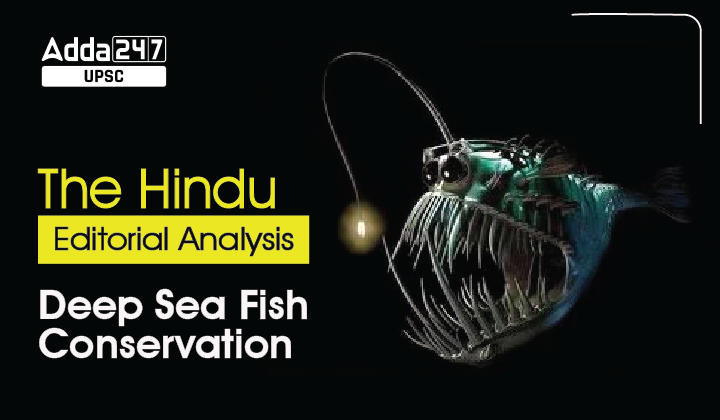Table of Contents
The Hindu Editorial Analysis: Deep Sea Fishing
Today’s The Hindu Editorial Analysis is based on Deep Sea Fishing Within EEZ And Conservation.
What Is The Issue?
Supreme Court’s Ruling On Deep Sea Fishing
- The Supreme Court of India has given permission to fishermen using purse seine fishing gear to fish beyond territorial waters (12 nautical miles) and within the Exclusive Economic Zone (EEZ) (200 nautical miles) of Tamil Nadu, but observing certain restrictions.
- Earlier, the Supreme Court passed an interim order on January 24, 2023, against the banning of purse seine fishing by the Tamil Nadu Government in February 2022.
Background
- On March 25, 2000, the Fisheries Department of Tamil Nadu had banned, inter alia, the use of Purse Seine Fishing nets within its territorial waters (12 nautical miles or 22 km from the coast line).
- However, Centre has placed no restrictions on Purse Seine method of fishing within Exclusive Economic Zone (EEZ).
What Is Purse Seine Fishing?
Purse Seine Fishing involves a method where a vertical net attached to a vessel is targeted at dense schools of fish in open water in curtain formation the bottom of which is drawn together to enclose the fish.
DTE Magazine July 2022, Part 1: ”The World is in Hurry Of Deep Sea Mining!”
Objection Raised By State Government?
The T.N. Government Submitted Before The Court:
- Purse seiners tend to overfish, unlike traditional fishermen using traditional fish gear, thus endangering the livelihood of the traditional fisher.
- PSF is a non-selective fishing technology which captures all kinds of fish including protected species.
- Moreover, it is a method which is used by affluent and rich fishermen or big fishing companies, as this technology is costly and is beyond the reach of ordinary fishermen.
What Is EEZ?
- An exclusive economic zone or EEZ is an area of the ocean, generally extending 200 nautical miles (230 miles) beyond a nation’s territorial sea, within which a coastal nation has jurisdiction over both living and nonliving resources.
- The concept of an exclusive economic zone (EEZ) was adopted through the 1982 United Nations Convention on the Law of the Sea.
- Under international law, within its defined EEZ, a coastal nation has:
- Sovereign rights for the purpose of exploring, exploiting, conserving, and managing natural resources of the seabed, subsoil, and waters above it.
- Jurisdiction as provided for in international law with regard to the establishment and use of artificial islands, installations, and structures; marine scientific research; and the protection and preservation of the marine environment.
- Other rights and duties provided for under international law.
What are Deepfakes and How does it work? Dangers and Solutions of Deepfake Technology
What UNCLOS Says On Deep Sea Fishing In EEZ?
- Under Articles 56.1(a) and 56.1(b)(iii) of UNCLOS, coastal states have sovereign rights to ensure that the living and non-living resources of the EEZ are used, conserved and managed, and not subject to overexploitation.
- Access to the zone by foreign fleets is also solely within the coastal state’s discretion and subject to its laws and regulations.
- In order to prevent overexploitation, coastal States must determine the total allowable catch (TAC) in the EEZ (Articles 61(1) and (2) of UNCLOS) in light of the best scientific evidence available.
Existing International Regulations And Guidance On Deep Sea Fishing Methods?
- International legal efforts are gradually moving in the direction of abandoning the use of large-scale pelagic nets. As, the huge size of the purse seine nets (2,000 metres in length and 200 m in depth) allows maximum catch for the purse seiners, in turn leaving behind insufficient catch for traditional fishermen.
- There are several regional organisations that either prohibit the use of large drift nets or at least call for their prohibition, such as the 1989 Tarawa Declaration of the South Pacific Forum.
- The 1989 Convention for the Prohibition of Fishing with Long Drift Nets in the South Pacific goes as far as to restrict port access for drift net fishing vessels.
- The United Nations General Assembly passed Resolutions 44/225 (1989) and 46/215 (1991) supported and strengthened this development, calling for a moratoria on all large-scale pelagic drift net fishing vessels in high seas.
- Although the conventions and the UN General Assembly resolutions are applicable to the state parties in the high seas, these are relevant in terms of preventing overfishing in general and the conservation of fishery management in the EEZ as well.
India’s Deep Ocean Mission: Explained
Conclusion
The theory of Garrett Hardin, ‘The Tragedy of the Commons’, which says ‘Freedom in a commons brings ruin to all’ should convince all fishermen, especially the purse seiners of Tamil Nadu and other states also, that they must cooperate in complying with conservation measures.



 TSPSC Group 1 Question Paper 2024, Downl...
TSPSC Group 1 Question Paper 2024, Downl...
 TSPSC Group 1 Answer key 2024 Out, Downl...
TSPSC Group 1 Answer key 2024 Out, Downl...
 UPSC Prelims 2024 Question Paper, Downlo...
UPSC Prelims 2024 Question Paper, Downlo...




